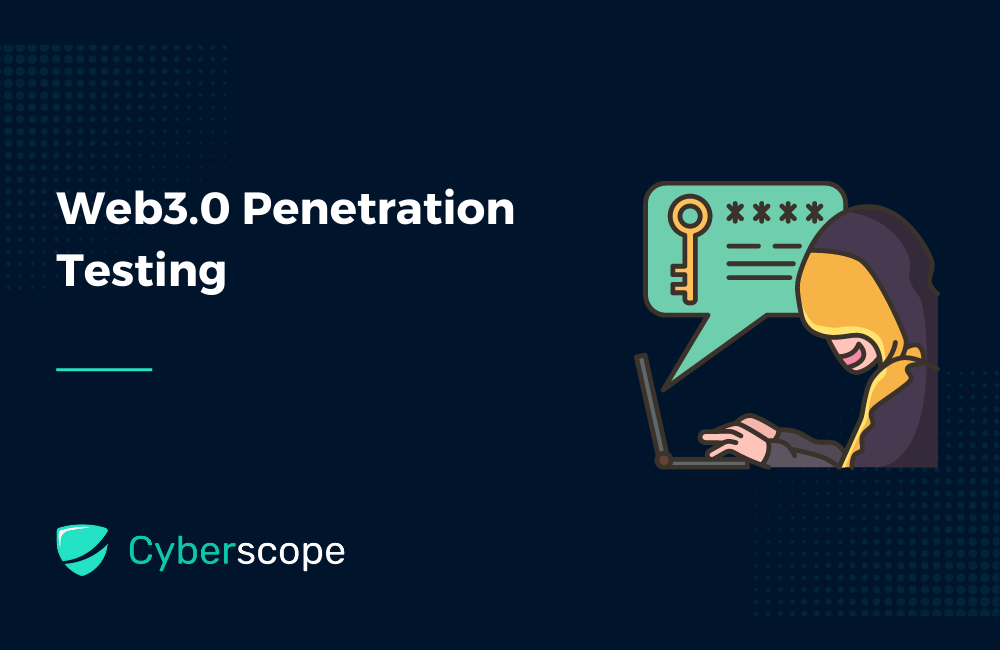.jpg%3Falt%3Dmedia&w=640&q=75)

Web3 Penetration Testing - A Deep Dive

Introduction
The term “Web3” describes the subsequent iteration of the internet, which will make use of blockchain technology and decentralized applications (dApps) to build a more transparent and secure web. In contrast to conventional web applications, Web3 apps utilize a distributed network of nodes to validate transactions and carry out additional functions.
Web3 has a lot of advantages, but it also has particular security issues. The usage of smart contracts, which are self-executing contracts built into the blockchain, is one of the largest obstacles. Reentrancy attacks, integer overflow attacks, and denial-of-service assaults are just a few of the many types of attacks that smart contracts are susceptible to.
The decentralized structure of Web3 apps presents a security concern. Because of the lack of a centralized authority or server to oversee security, it may be more difficult to uncover flaws. Furthermore, because Web3 is an open-source platform, hackers can readily access the code and uncover holes, emphasizing the significance of ensuring the security of Web3 applications to prevent any breaches or assaults.
It’s crucial to carry out specialist penetration testing for Web3 apps given these particular difficulties. Smart contracts, dApps, and other Web3 components are subjected to security testing known as “Web3 penetration testing” in order to find weaknesses and potential attack points. This kind of testing needs specific skills and equipment, as well as knowledge of the particular difficulties posed by Web3.
The Significance of Web3 Penetration Testing
The importance of Web3 penetration testing can be attributed to its role in ensuring that decentralized applications running on blockchain networks are safe and shielded from potential threats. It also helps to guarantee that an application is secure by simulating attacks on it to find any gaps in its security measures. Organizations can proactively identify and address vulnerabilities before they are used by attackers by regularly conducting penetration tests.
It is crucial to make sure that these applications are not exposed to any security concerns because they frequently transmit sensitive data and assets. Penetration testing is even more important because the Web3 environment is so young that its particular security issues are poorly understood. These difficulties include the usage of diverse protocols and interfaces, smart contract weaknesses, and network decentralization.
A level of assurance that sensitive data and assets are safeguarded from unwanted access is provided by Web3 penetration testing’s capacity to identify and address vulnerabilities in decentralized apps.

Web3 vs Traditional Web Penetration Testing
There are various ways that web3 penetration testing is different from conventional web penetration testing. First off, unlike standard web apps, Web3 applications operate in a decentralized context, which has special security challenges. For instance, smart contracts that operate on the blockchain may have security flaws that might be used by attackers. Additionally, Web3 apps employ many protocols and interfaces, including RPC and JSON-RPC, which necessitate specialist testing equipment and knowledge.
The second reason is that Web3 applications leverage blockchain technology, which is intrinsically safer than regular web apps. This does not imply that Web3 applications are safe from security risks, though, as flaws in the code or how the application communicates with the blockchain still might exist.
Finally, when doing penetration testing, it is important to keep in mind that Web3 applications are subject to certain regulatory requirements. Decentralized finance (DeFi) applications, for instance, may need to adhere to financial regulations. This must be taken into account when looking for vulnerabilities.
Specialized Knowledge and Tools for Web3 Penetration Testing
Web3 penetration testing requires specialized knowledge and tools due to the unique nature of decentralized applications that run on blockchain networks.
Decentralized nature of Web3: Web3 applications function in a decentralized environment, which means they are not under the jurisdiction of a single entity, in contrast to traditional web applications. Due to decentralization, there are new security issues that are not present in conventional web apps. For example, smart contracts must be secured, and blockchain transactions must be protected.
Smart contracts’ weaknesses: A crucial component of many Web3 apps, smart contracts are used to automate transactions on the blockchain. However, smart contracts may include flaws that attackers might take advantage of, such as denial-of-service attacks, reentrancy attacks, and integer overflow/underflow. Specialized expertise in programming languages for smart contracts, like Solidity, is necessary to efficiently test for these vulnerabilities.
Regulation: Compared to standard web apps, Web3 applications are subject to various regulations. Decentralized finance (DeFi) apps, for instance, may need to adhere to financial rules; this must be considered when looking for vulnerabilities.
Web3 protocols and interfaces: Web3 applications employ a variety of protocols and interfaces, including RPC and JSON-RPC, which need specific testing equipment and knowledge. These protocols enable interaction between Web3 apps and the blockchain, but they also provide possible security problems that need to be investigated.

Planning and Scoping
Effective Web3 penetration testing requires careful planning and scope. To guarantee that all potential vulnerabilities are found and evaluated, successful Web3 penetration testing needs thorough planning and scoping. Critical phases in the planning and scoping process include establishing clear objectives, setting targets, comprehending the architecture and technologies involved, defining testing techniques, and creating a testing strategy.
Here are some crucial factors to take into account before beginning Web3 penetration testing:
Defining aims and establishing clear objectives: Clearly defining objectives and the scope of the test is the first stage in planning for Web3 penetration testing. This entails choosing precise testing targets, such as wallets, decentralized apps (dApps), and smart contracts. In order to make sure that all potential vulnerabilities are found and evaluated, it’s crucial to have a thorough awareness of the target environment.
Recognizing the technology and architecture: Having a solid understanding of the architecture and technology is important since Web3 apps employ different structures and tools than conventional web applications. Conducting successful penetration testing requires a thorough understanding of the particular architecture and technologies present in the target environment. This may entail an understanding of Web3 protocols and interfaces, smart contract programming languages (such as Solidity), and blockchain technology. (such as RPC and JSON-RPC).
Specifying testing procedures: Specifying the testing procedures that will be employed is crucial when the goals have been determined and the target environment has been comprehended. The approaches used may be both automatic and manual, and there may also be particular tools and frameworks designed only for Web3 penetration testing.
Making a testing plan: After defining the objectives, targets, and testing techniques, it’s crucial to make a plan for the tests that will be carried out, the tools that will be utilized, and the timing of the testing. Before testing starts, this strategy has to be reviewed and authorized by all parties involved.

Exploiting and Analyzing Vulnerabilities
To guarantee that all potential vulnerabilities are found and evaluated, successful Web3 penetration testing needs thorough planning and scoping. Critical phases in the planning and scoping process include establishing clear objectives, setting targets, comprehending the architecture and technologies involved, defining testing techniques, and creating a testing strategy.
Vulnerabilities in smart contracts: Smart contracts are self-running programs that are kept on a blockchain network. They are made to enforce laws and automate transactions without the aid of middlemen. Reentrancy, integer overflow/underflow, time manipulation, and logic problems are just a few of the threats that smart contracts are susceptible to. These flaws provide attackers with the ability to freeze a contract, steal money, or run arbitrary code.
Vulnerabilities associated with decentralization: Decentralized systems are intended to function without a single point of control. Decentralization, however, may also lead to weaknesses including network splintering, Sybil attacks, and 51% assaults. These assaults have the potential to jeopardize the network’s availability and integrity, opening the door for transaction manipulation and money theft.
Vulnerabilities related to interoperability: Interoperability allows various blockchain networks to talk to and interact with one another. But this might also bring flaws like inter-blockchain communication flaws and cross-chain attack flaws. Attackers may be able to modify transactions, run arbitrary code, and steal money using these techniques.
Vulnerabilities in wallets: To handle and store bitcoin, wallets are utilized. They are susceptible to phishing, malware, and social engineering attacks, among other forms of attacks. Attackers may use these methods to steal money or obtain access to private data.
Tools
The distinctive design and technology of blockchain-based apps need the use of specialist tools and methodologies for Web3 penetration testing. These tools can assist developers and security experts in identifying and remediating vulnerabilities before attackers can exploit them.
Cyberscope provides everything needed for organizations seeking to mitigate the risk of attacks and safeguard their users’ assets and data in the Web3 ecosystem. Through the expertise of their knowledgeable and skilled professionals and the utilization of specialized technologies, Cyberscope offers a comprehensive testing strategy to enhance Web3 security.
Mythril: Mythril is an Ethereum smart contract security analysis tool. It is capable of spotting several different vulnerabilities, including reentrancy, integer overflow/underflow, and logical errors.
ZAP: To check the security of decentralized apps, utilize ZAP, a web application security scanner. It comes with a selection of specialist plugins for testing Ethereum and Bitcoin and other blockchain-based apps.
Oyente: Another security analysis tool for Ethereum smart contracts is called Oyente. It can identify weaknesses including timestamp reliance, transaction sequencing issues, and gas limit issues.
EthFiddle: With the help of the web application EthFiddle, programmers can create and test Ethereum smart contracts in a browser-based setting. It has simulation tools and an integrated debugger for evaluating the functionality and security of contracts.

Best Practices and Obstacles
Because blockchain-based systems are decentralized, distributed, and unchangeable, Web3 penetration testing poses a number of special difficulties. The followings are some difficulties and recommended techniques for Web3 penetration testing:
- Limited access: Due to the decentralized nature of blockchain-based apps, it may be challenging to acquire access to the network’s core code and data.
- Complex architecture: Web3 applications are based on complicated architectures with several layers of protocols and technologies, making it difficult to spot weaknesses and possible points of attack.
- Immutable data makes it harder to repair vulnerabilities once they have been exploited since once information is added to the blockchain, it cannot be erased or changed.
- Lack of standards: It may be difficult to create uniform testing procedures and tools due to the absence of standards in the blockchain sector.
Εxemplary Practices
You should always gather as much information as you can about the target application, including the blockchain network, smart contracts, and other components, before conducting a penetration test.
Utilize specialist tools: To find vulnerabilities and potential attack vectors, use specialized tools and frameworks made just for Web3 penetration testing.
Test smart contracts: To find and fix vulnerabilities in this crucial part of Web3 applications, specific testing approaches are needed.
Attack simulation: Without endangering the application or network, attack simulation can assist in finding security gaps and evaluating the efficacy of security measures.
Consult with experienced professionals: Web3 penetration testing necessitates unique knowledge and abilities. A thorough and efficient testing strategy may be ensured by working with competent security specialists.
Follow industry best practices: Adhere to industry best practices for security and testing, such as the Blockchain Threat Model and the Open Web Application Security Project (OWASP).

Why Is Penetration Testing for Web3 Important?
Web3 technology poses particular security difficulties that conventional cybersecurity techniques might not be able to fully solve. For instance, because Web3 apps are decentralized, there is no centralized authority to impose security norms or protocols. Additionally, any security flaws might have a significant impact due to the openness and immutability of blockchain-based systems.
A thorough cybersecurity plan must include both offensive and defensive protection. It’s critical to take defensive security measures to guard against known threats and weaknesses. On the other side, offensive security is a useful technique for locating previously undiscovered weaknesses.
A team’s incident response strategy may be evaluated for efficacy via offensive security testing. Web3 penetration testing can assist companies in identifying areas in which their incident response strategy may be deficient by simulating a breach. In order to ensure a more effective reaction in the case of a genuine security crisis, this is the first step.
Conclusion
For locating and resolving security flaws in blockchain-based apps, Web3 penetration testing is essential. To solve the special issues posed by Web3 apps, such as smart contract vulnerabilities, decentralization vulnerabilities, interoperability vulnerabilities, and wallet vulnerabilities, specialized tools, and approaches are needed. To guarantee the continuous security and integrity of Web3 applications, regular penetration testing is required. For fast and successful Web3 penetration testing, cooperation with knowledgeable security experts is essential. To reduce the risk of attacks and protect users’ assets and data inside the Web3 ecosystem, Cyberscope provides the services of educated and professional specialists who can conduct a thorough testing strategy using specialized technologies. To discover more about Cyberscope’s services or to improve their Web3 security, organizations may get in touch with them.
Recent Posts
.jpg%3Falt%3Dmedia&w=640&q=75)


What is a Fallback Attack in Smart Contracts?
5 months ago
